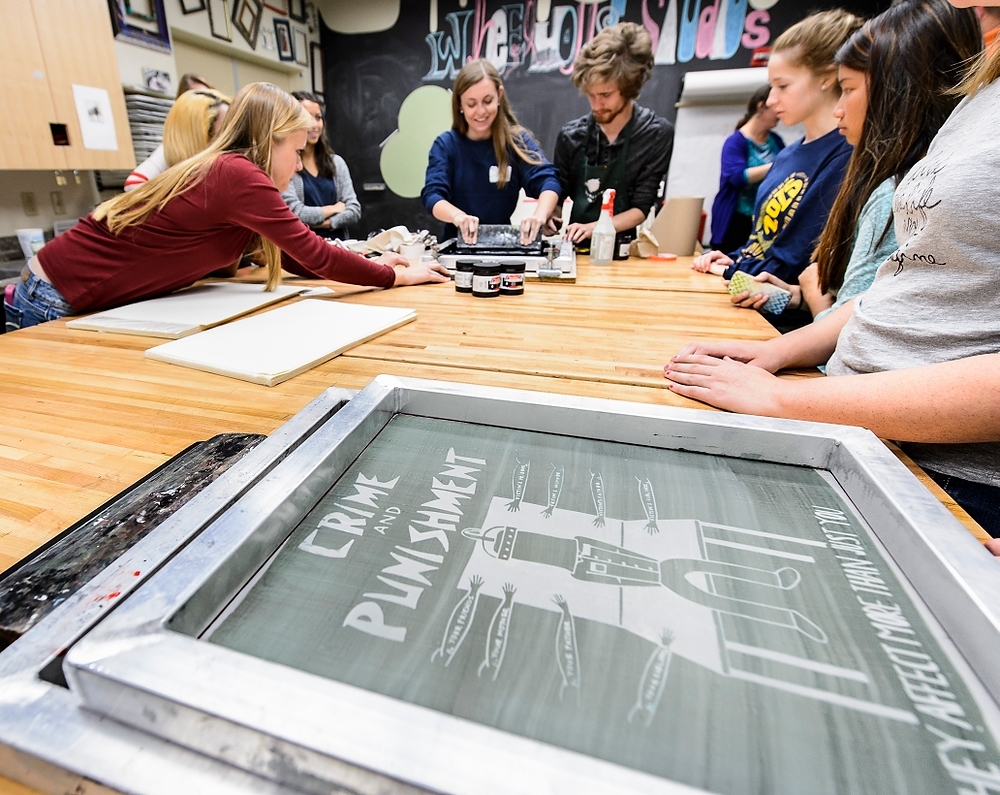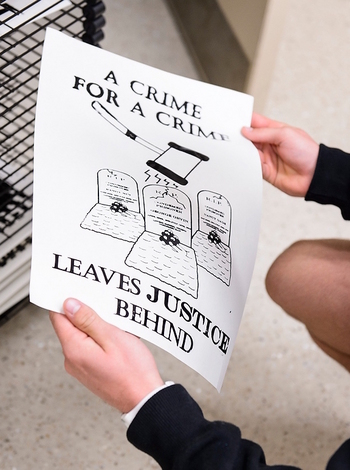From page to poster: Business students create art inspired by ‘Go Big Read’ selection

Students from the Wisconsin School of Business use silk-screening techniques to create posters as part of a Just Mercy Printmaking Project. The students designed the artwork after reading “Just Mercy” by Bryan Stevenson, this year’s Go Big Read selection.
“What if you were labeled as the worst thing you had ever done?”
“A crime for a crime leaves justice behind.”
First-year students at UW–Madison created these and other slogans for a poster project at Wheelhouse Studios inspired by this year’s “Go Big Read” selection. The book, “Just Mercy: A Story of Justice and Redemption” by Bryan Stevenson, describes his experiences as a lawyer confronting inequities in the justice system and advocating for reform.
The project led students to connect very different disciplines: art, law, politics, business. It’s part of a class, “Principles in Leadership, Ethics, Authenticity and Development,” offered to direct admit students in the Wisconsin School of Business.
“There is an incredible tradition of screen-printing and poster-making as part of social change,” says Angela Richardson, Aesthetics and Business Project Coordinator for the Bolz Center for Arts Administration in the Wisconsin School of Business.
“Our printmaking project was designed to create an opportunity for students to discuss and think deeply about mass incarceration, police brutality, and problems with the criminal justice system,” she says. “By working together in small groups to design and create their own posters, they add their voices to the ongoing dialogue around these issues.”
Working in groups of 10, students had to conceptualize and design their posters in 48 hours or less.
“We framed this experience not only as having to do with social justice and social change, but posed it to the groups as a short turn-around deadline and said, ‘Okay, imagine that you are a marketing and branding team and we need you to come up with a campaign that has to do with some of the ideas around this book and we need you to do it now’,” Richardson says.
The benefit of the art-business collaboration goes further than learning to meet deadlines.
“Much of the way we understand what’s going on in the community is through art,” says William Schuth, an instructor for the course who also serves as an academic advisor in the Wisconsin BBA Program.
“[Having the ability to understand art] also makes the students better community members,” he says. “Whether you’re an artist or a businessperson, we all belong to the same community and we all are affected by forces that are beyond our individual control. Having a way of developing a little bit of vocabulary between those two groups is really crucial to having a coherent community.”
Students designed 12 posters and then had the chance to screen print them at Wheelhouse Studios in Memorial Union.
Richardson, studio director Jay Ekleberry and Dani Barker, the lead instructor for the course, came up with the idea for screen-printing the posters.
“We’ve all been to a million panel discussions where you bring in the experts and they spew their expertise and you leave and it doesn’t make much of a difference,” says Ekleberry. “But if you actually engage people in the creative process, hopefully they start to generate new knowledge amongst themselves.”
A portfolio of the posters will be given to the author when he speaks in Varsity Hall at Union South on Oct. 26.
In addition to the poster designs, students also learned to bind books, which are to be donated to the Wisconsin Books to Prisoners and LGBT Books to Prisoners Programs.
“The Books to Prisoners Program recently made a request for donations of blank notebooks because people in prison have a great need for them,” says Richardson. “So, this is also a cool chance to teach students a really interesting skill.”
– Madeline Fischer





